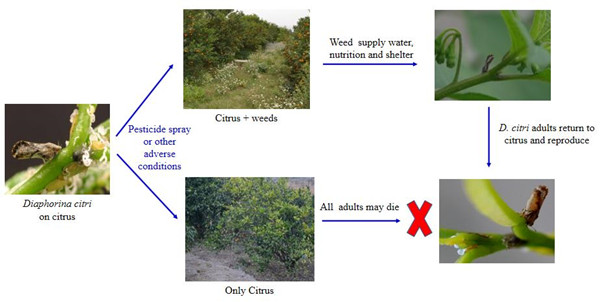The role of plants beyond Rutaceae in the transmission of huanglongbing was revealed
The Asian citrus psyllid Diaphorina citri Kuwayama is a vector of Candidatus Liberibacter asiaticus (CLas), which are associated with citrus huanglongbing, a devastating disease affecting citrus almost worldwide. As the host range of the psyllid is limited to several genera in the family Rutaceae, the current monitoring and control scope of psyllid and huanglongbing is limited to Rutaceae. However, D. citri has been suggested to use a wider array of alternative hosts beyond Rutaceae as temporary reservoirs for food and moisture, and even complete generations, which has attracted attention in the field of huanglongbing monitoring and control. In the field investigation, the Research Center for Environmental Entomology of Institute of Zoology, Guangdong Academy Sciences found that D. citri adults could stay on Solanum nigrum in citrus orchards under natural conditions, and CLas was detected in the leaves of this weed by quantitative polymerase chain reaction (qPCR) analysis .
Taking Ageratum conyzoides, the most common weed in citrus orchards in South China, and Praxelis clematidea, a weed of the same family with similar morphological characteristics, as materials, researchers confirmed that there were significant differences in the selectivity and survival period of D. citri adults to different weed species. The selection ratios of D. citri adults to A. conyzoides and P. clematidea were 31.52% and 16.22%, respectively. At an average temperature of 35 ℃, the longest survival time of adults was 48 days on A. conyzoides, only 11 days on P. clematidea, and less than 1 day without food and water. And laboratory experiments showed that the mortality of D. citri adults was 42.76% in the presence of both citrus and A. conyzoides, while their mortality was 79.49% if only citrus seedlings were present after the potted citrus plants were sprayed with avermectin EC. The CLas titres of D. citri adults feeding on the three weeds for 1 week increased significantly during autumn but did not change significantly during spring. Conversely, the titres of adults on citrus increased significantly during spring but did not change significantly during autumn. It can be speculated that pathogen had a certain synergistic effect on D. citri to adapt to non Rutaceae plants, so as to aggravate the transmission and diffusion.
The above results showed that some plants belonging to families other than Rutaceae would become temporary shelters for psyllids to avoid adverse conditions and long-distance relocation diffusion, thus affecting the accurate monitoring and effective control of psyllids and huanglongbing. These research results are an important supplement to the catastrophe mechanism of huanglongbing, and they can provide important guidance for perfecting and improving the huanglongbing prevention and control system and making up for the loopholes of prevention and control. And it also provides a reference for further study on the host spectrum expansion risk and mechanism of psyllids and huanglongbing.

Fig. Weeds surrounding citrus plants may increase the risk of Diaphorina citri dispersal and resurgence.
The research paper, entitled "Adaptability and ‘Candidatus Liberibacter asiaticus' titres of Diaphorina citri adults on three weed species in China", was published online in the famous international academic journal "Pest Management Science", with Dr. Lu Huilin of Institute of Zoology, Guangdong Academy of Sciences as the first author and researcher Ouyang Gecheng as the corresponding author. This research was supported by National Natural Science Foundation of China (3157213), Special Project of Guangdong Academy of Sciences (2019GDASYL-0105047), and GDAS Special Project of Science and Technology Development (2018GDASCX-0107).

